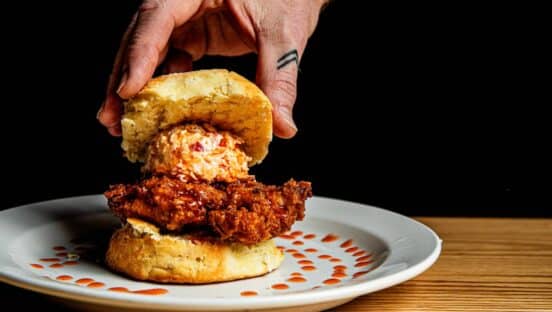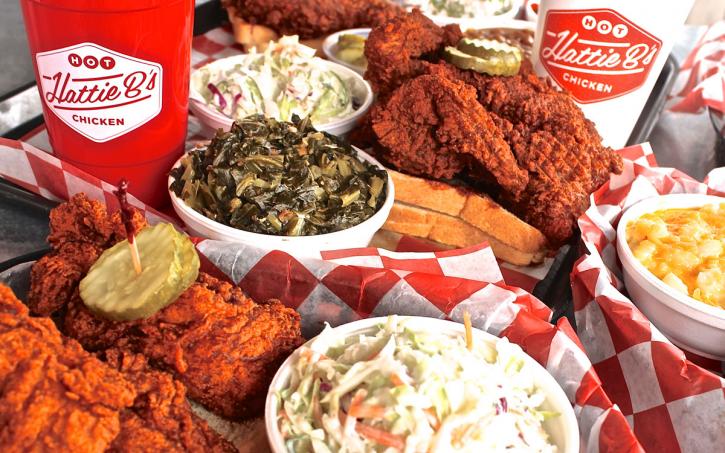
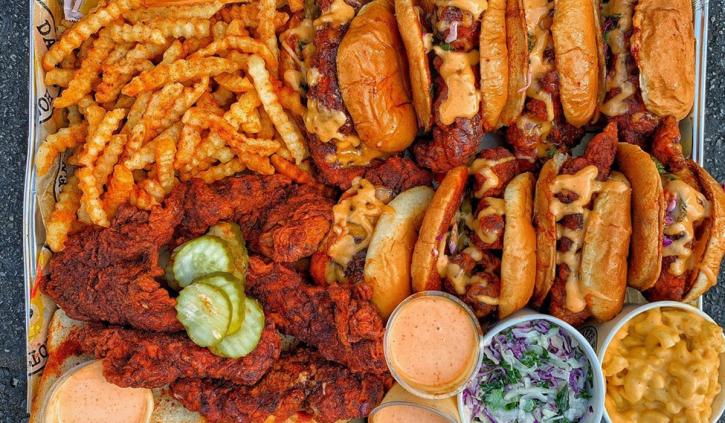
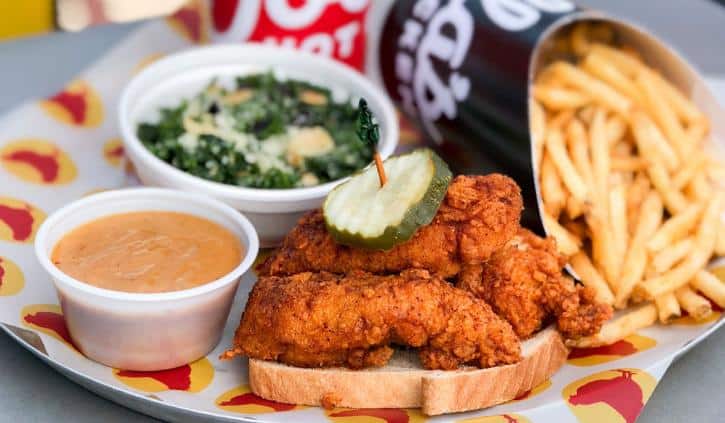
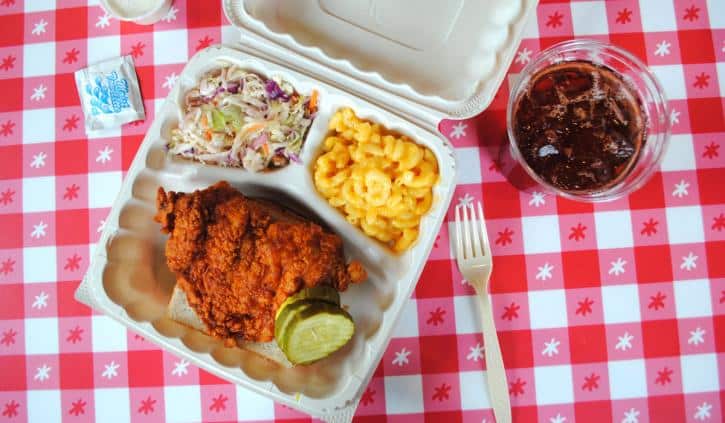

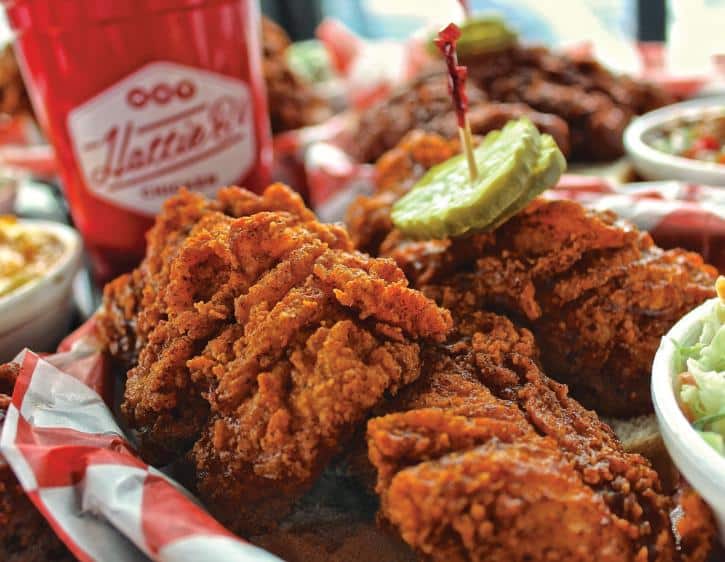

Hot in here
Just as with any cultural phenomenon, there is sure to be an origin story. Nashville’s signature dish, hot chicken, isn’t an exception. The most referenced legend comes from a century ago, when a scorned lover of Thorton Prince III doused his favorite meal with cayenne pepper. Rather than burn up, Prince fell in love, and he and his family spent the following decades working to perfect the meal.
The James Beard Foundation awarded Prince’s Hot Chicken Shack the America’s Classics Award in 2013 for its cultural impact after decades of serving hot chicken. JBF reasoned that, thanks to Prince’s, “Nashville hot chicken” is just as much of a staple as “Memphis barbecue” or “Charleston she-crab soup.”
Now, a century after the fabled discovery of the dish, hot chicken is emerging as a popular choice for diners all over the country.
Here are six hot chicken restaurant concepts capitalizing on the popularity and expanding across the U.S.
Dave’s Hot Chicken
With just two locations, this concept has national goals and the investment backing to do it. Bill Phelps, the CEO of Dave’s Hot Chicken, was a cofounder of Wetzel’s Pretzels, which now has 350 locations and $150 million in sales. Phelps was also an original investor of Blaze Pizza.
Along with Phelps, the concept—originally launched by chef Dave Kopushyan in 2017—is backed by multiple recognizable names, including Maria Shriver and movie producer John Davis, both of whom were original investors in Blaze Pizza in 2011. Dave’s Hot Chicken also has backing from Good Morning America anchor and former football star Michael Strahan, as well as actor Samuel L. Jackson.
After the success of his two previous ventures, Phelps has his eyes set on hot chicken, which he says has national growth potential that is unparalleled.
“The product experience is phenomenal and far elevated compared to traditional quick-service and fast-casual chicken chains,” Phelps said in a statement. “We’re looking forward to partnering with multi-unit operators to bring Dave’s to major markets across the country.”
Joella’s Hot Chicken
Joella’s Hot Chicken focuses on the ideals of Southern-style cooking and melds them with a spice level that ranges from mild to “fire-in-da-hole,” which requires a signed waiver from the customer.
Louisville, Kentucky–based Joella’s was founded in 2015 and has grown to 12 locations to date in Kentucky, Florida, Georgia, Indiana, and Ohio. There are opening dates set for two more units in Florida and Georgia and five more coming soon in other states.
Christina Happel, regional vice president of operations for Joella’s, said in a statement this summer that the spice of the chicken isn’t the focus of the hot chicken concept.
“Hot chicken isn’t just about heat—it’s about flavor,” Happel says. “And that’s why current guests have embraced Joella’s. We’re thrilled that we are doubling the number of restaurants serving up just the right amount of spice and a heaping side of Southern hospitality.”
Hot Chicken Takeover
When Joe and Lisa DeLoss founded Hot Chicken Takeover (HCT), they had just taken a “babymoon” to Nashville where they were inspired by the hot chicken concept. The pair then experimented with a recipe until they were comfortable enough to begin serving their results, and they founded a concept in Columbus, Ohio, with a focus on the food, yes, but also the people.
HCT offers a variety of chicken products and sides, with heat levels from cold to “holy ––.” HCT also offers “Not Chicken” products, which are made from a house seitan.
HCT advertises that it provides supportive jobs to men and women who need a fair chance at work. Regardless if the individual is dealing with homelessness, previous incarceration, or other barriers to employment, HCT will give them a chance with the stipulation they have a commitment to personal growth.
HCT also offers team members professional development, cash advances and 0 percent interest loans, and licensed counseling.
Sonny & Sons
Founded by “Top Chef” winner Kevin Sbraga, Sonny & Sons opened in August in a food hall development near Purdue University in West Lafayette, Indiana.
“Fifty-five thousand people within two square miles is pretty dense,” Sbraga says. “There are pretty limited options in terms of freestanding [restaurants] that are not traditional school dining, that are independent. And students nowadays are demanding better food. You look at the millennials and the next generation, and they want better things.”
The menu for the concept is limited—hot chicken in the form of a sandwich, tenders, jumbo wings, or a half bird, with various sides—but Sbraga says it’s embracing the idea of comfort food and putting a little twist on it.Sbraga says he’s looking forward to a future with a counter-service brand that is elevated and refined, leading him to work on perfecting the systems at the Purdue unit before scaling it to other locations.
“With the fast-casual model, coming from fine dining, I’m not trying to recreate myself every time. I’m not trying to recreate a new concept,” Sbraga says. “I’m just trying to reproduce what we’ve already done—just produce it again. If we set those systems up in the beginning, it should make life a lot easier in the long run.”
Hattie B’s
With three units in Nashville, three more in other Southern states, and one in Las Vegas, Hattie B’s didn’t invent hot chicken, but it’s doing its part to serve it to the masses.
Nick Bishop Sr. and Nick Bishop Jr. founded Hattie B’s in 2012, while they were still operating Bishop’s Meat and Three, a single-unit cafeteria-style concept Bishop Sr. opened in 2007. When Bishop Jr. joined the team, they wanted to expand their flavors and styles and decided hot chicken was the medium to do just that.
In 2012, the Bishops debuted their one-protein, six-heat-level menu with playful names like Damn Hot and Shut the Cluck Up in midtown Nashville. The menu is straightforward; guests choose their chicken cut and size (or tenders and wings) plus sides. But that simplicity resonated, and the community quickly rallied around the fast casual.
“[Looking ahead,] it is truly doing the best we can with every opening and opportunity we get, making great decisions, getting better at what we do, and then moving on to the next restaurant,” Bishop told QSR last September. “We’re going to be smart and thoughtful in our approach as we grow, and I think the sky’s the limit.”
Howlin’ Ray’s
Before he established his Los Angeles locations, founder Johnny Zone first had hot chicken at Prince’s Hot Chicken in Nashville, and he fell in love.
“I decided to go to all the hot chicken places in Nashville. I flew back to meet every single owner and talk to them about the history of it to understand the culture of hot chicken—who’s eating it, why they’re eating it, why they love it—and to really do my due diligence in that sense, to pay homage,” he told QSR in April. “If you don’t understand a dish’s origins, conceptually as a chef, it’s hard to replicate.”
Zone and his wife Amanda chose a food truck first and then moved to a 500-square-foot Chinatown location, then expanded to the space next door. Howlin’ Ray’s initially served 175 people in a day three years ago, and has grown to figures 10 times that.
“Once we get to a second store, we’re going to let the restaurant take a course of its own, let the business dictate where it wants to go versus trying to open 300 units,” he says. “If your expansion, growth model, and goals don’t fall in line with that answer, then chances are you’re losing a little bit of the identity of the business.”

